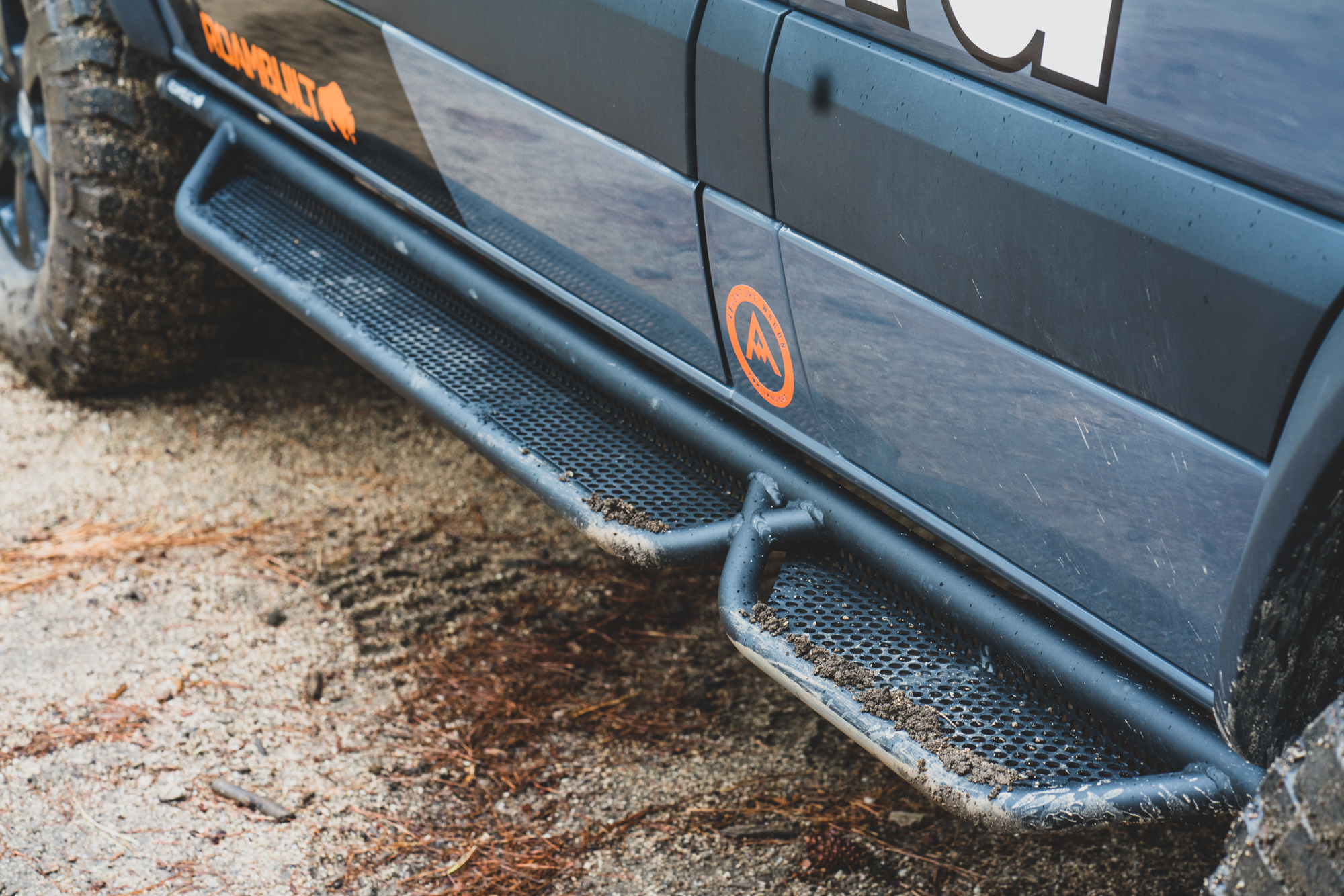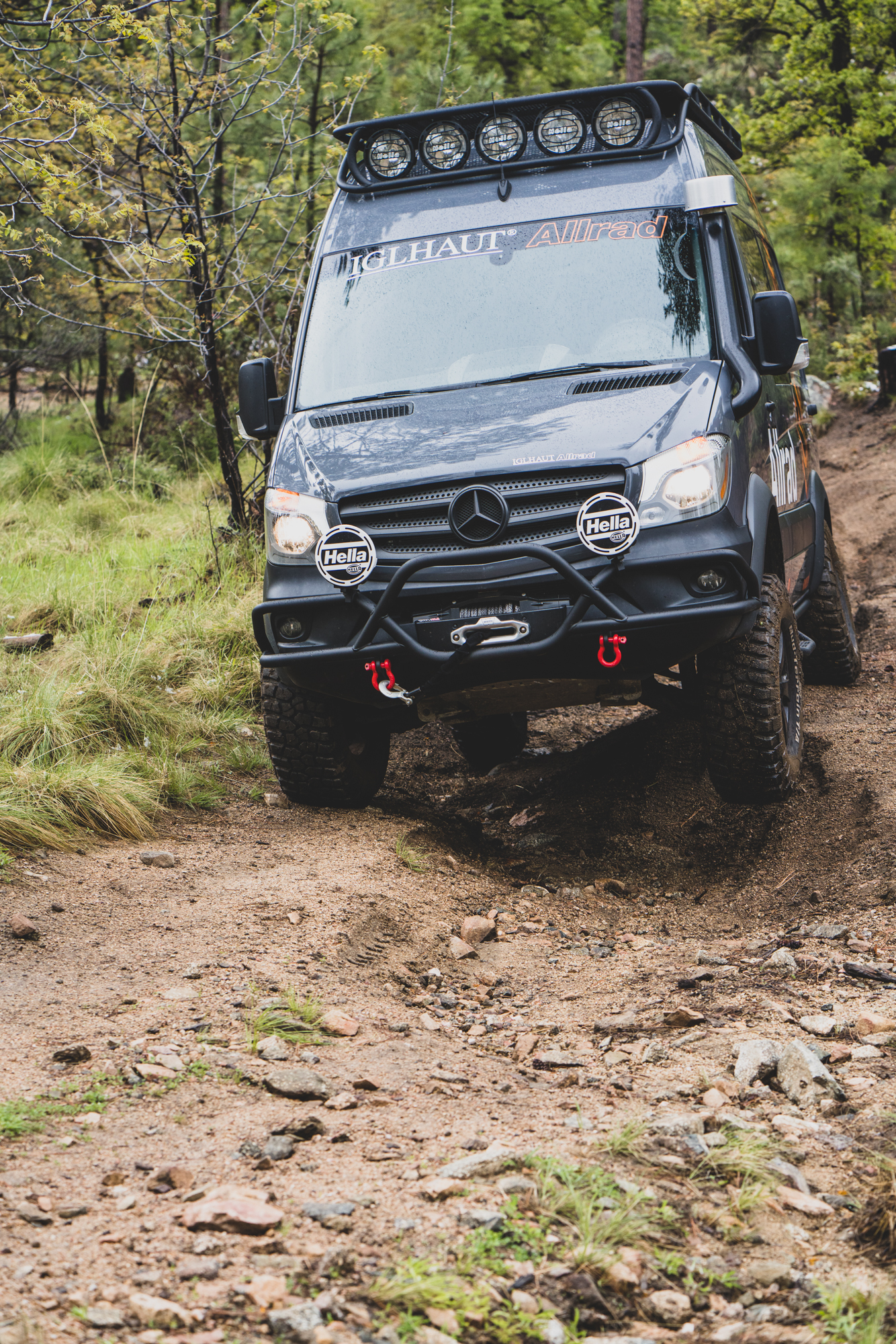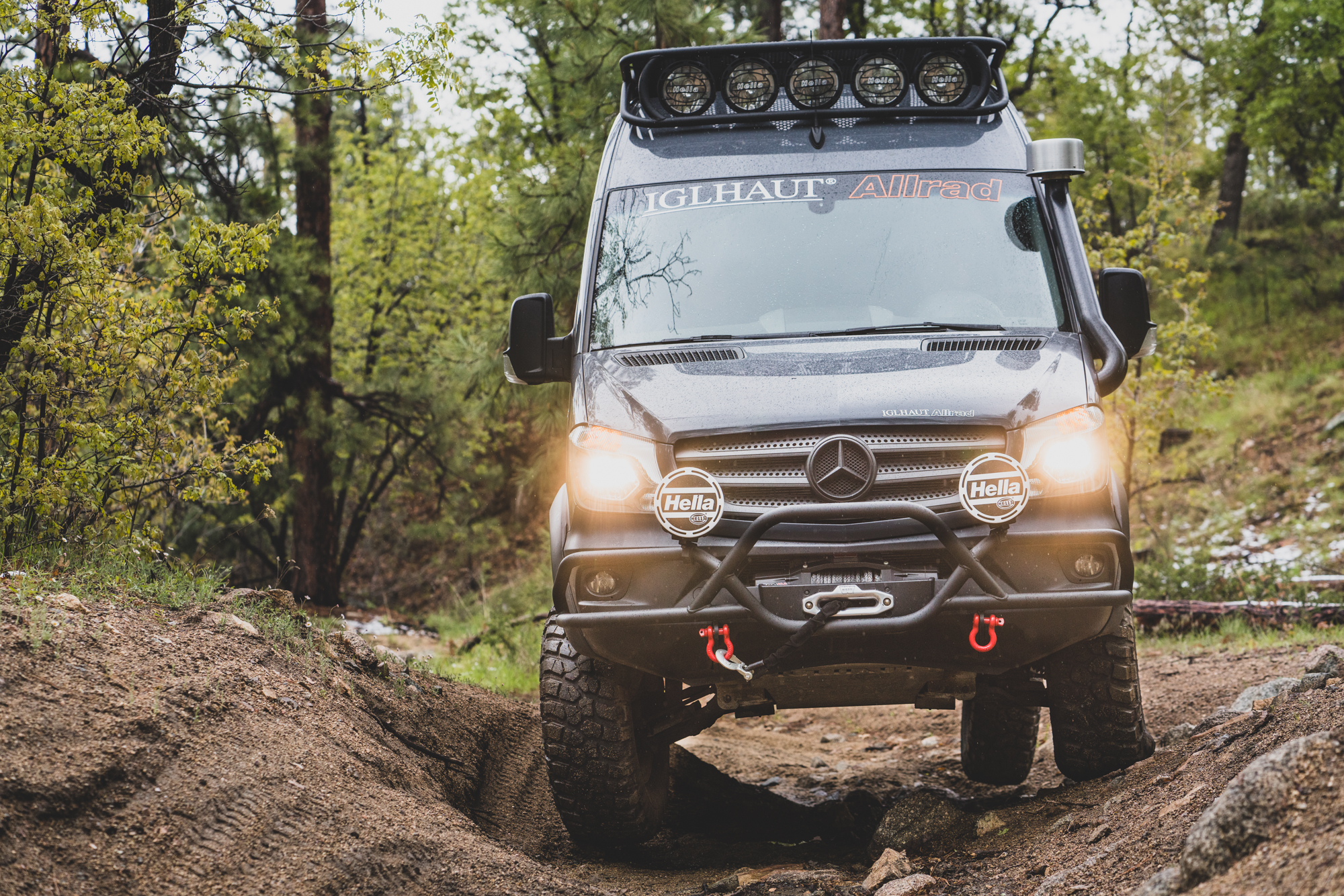If your plan is to travel remotely, capability is a key attribute of the vehicle you choose. While much of exploration is done on dirt roads and trails, the backcountry is filled with challenges and obstacles, including washouts, boulder-strewed washes, deep-water crossings from seasonal rains, thick mud, and soft sand. This is why I personally prepare my vehicles with reserve capability, as you never know what adventure might be around the next corner. For the Sprinter owner, there are few conversions that match the breadth of performance and 4WD specifications like the Iglhaut.

The Iglhaut conversion includes proper skid plates and engine/transmission/transfer case protection.
Last year, I had the opportunity to test the Iglhaut conversion on our test track in Prescott, Arizona, a route complete with corrugations, cross-axle terrain, and technical climbs. While we did not have time to complete the entire loop, I am quite confident the Iglhaut would successfully complete all of it. But fortunately, we were able to get into the heavier cross-axle sections, which gave me a chance to evaluate the platform and enhancements.

It is important to note from the beginning that the Sprinter is not intended to be a rock crawler or a recreational 4WD for conquering 3+ trails in Moab. Despite the Iglhaut improvements, there are still limitations due to length and height. However, I have had the opportunity to test stock 4WD Sprinters on trails, and even 4WD converted Ford E350s, so this makes for a good baseline for comparison. But before I start with the impressions, why consider the Iglhaut conversion?
In stock form, the AWD Mercedes Sprinter can be purchased with standard AWD and traction control, or with an optional low-range transfer-case providing a 42 percent gearing reduction. There are several limitations to this system, primarily the poor 1.42:1 low range ratio, and the lack of a locking center differential. The factory system splits the torque 65 percent to the rear axle, and 35 percent to the front. This is partially augmented by the 4ETS system, which uses brake-traction control to limit wheelspin and improve on the performance of the AWD torque split (again, by limiting wheelspin). In moderate terrain, this all works as desired, but once things get either steep or heavily cross-axled, the system is limited at best. I found the stock system to allow far too much wheelspin, and the low range too high-geared to overcome the torque impact of traction control intervention. The factory system is just fine for dirt roads and the occasional sand/mud/snow, but some travelers want to venture further.
Enter the Iglhaut conversion, which starts with a 2WD Sprinter of your choice, which can include the older non-DEF diesels. This is particularly notable, as 2WD Sprinters are easy to find and start off less expensive. The owner then works with Iglhaut USA to ship the vehicle to Germany, where the complete conversion is performed. They use a 2WD chassis, as none of the factory AWD components are suitable for a complete 4WD conversion. The upgrades include an entirely new front axle and suspension, all-new transfer-case with 2.5:1 low range (and a locking center differential), increased ground clearance, and skid plate protection. Options are also extensive, including a snorkel, front and rear differential locks, full skid plates, and even the fitment of a 37-inch tire.
Key Improvements and Specifications of the Iglhaut Conversion:
1. Heavy-duty front axle and independent suspension upgrade with 4 inches of lift over stock
2. Available front differential lock (driver selectable)
3. All-new transfer case with 2.5:1 low range and locking center differential (driver selectable)
4. Standard and optional skid plate packages
5. 35-inch tire standard fitment, 37-inch tire option
6. Snorkel with pre-filter (separator)
7. Optional big brake package
8. Optional adjustable coil-over suspension system with remote reservoir
9. Larger fuel tanks, up to 170 liters (45 gallons)
Approach Angle: 35 degrees
Departure Angle: 31 degrees
Breakover 144″: 29 degrees
Gradeability (slope): 80 degrees
Minimum Ground Clearance (at rear axle): 10.2 inches
Fording (wading) depth: 28 inches

The unit I tested is the demo vehicle for Iglhaut Allrad USA, which includes the larger 37-inch BFGoodrich Mud Terrains, and a suite of Roambuilt accessories (check out the Roambuilt adventures). Modifications included a full-length rack with ladder, structural side steps (which function as modest sliders), a rear bumper, and a front bumper with winch. While these accessories added to the vehicle weight, the interior build was modest, and everything was well within the payload of 4,000+ pounds (GVWR).


The Roambuilt bumper does a nice job of protecting the rear quarter panel and the factor plastic bumpers. Integrated tow/recovery points are worth noting, as is the Warn winch fitment.


Completing the Roambuilt package is the side steps/sliders and the full-length rack with enough Hella lights to land an Antonov.
On the trail, the size of the vehicle was immediately apparent, as we typically test SUVs and trucks on this route. In the case of the Sprinter, it is all about the third dimension, which is the height. And while it might be tempting to infer that means a high center of gravity, it really does not. The Sprinter is quite wide, and the majority of the weight is down low. It is a tall, empty box. As a result, it felt appropriately stable, but trees and branches were the concern. Bring along a good saw.
I shifted the Iglhaut into low range via the floor-mounted lever (thank you!), which clearly indicates H – N – L, and engages with an appropriate thump. The 2.5:1 ratio and the torque of the diesel provides good control, particularly when paired with the automatic transmission and left-foot braking. That was my first aha moment, as I remembered the stock AWD Sprinter laboring in low range over rocks or the most modest of climbs.


Left: A real transfer case (German built), with a proper low range ratio of 2.5:1. Right: This is where all of the magic happens, like a G-Wagen with center, rear, and front differential locks.
Driving the Sprinter into the first cross-axle section, I noticed the slightest rotation of the down-slope front tire. No problem, I engaged the center differential lock (I intentionally waited to do this to evaluate the AWD performance with the center diff open). The van moved forward again and cleared the first several obstacles with only the center locked. One of those challenges is a significant side slope, nearing 30 degrees. I did not place the vehicle at the maximum angle possible but achieved 24 degrees on my trusty iPhone clinometer. The van felt stable, without notable sway, a testament to the suspension tuning, and anti-roll bar rates. From there, the challenges grew more significant, with deep cross-axle holes and soft, muddy soil.
After completing the side slope, I entered a series of deep cross-axle ravines, which began to test the limits of articulation on the 144″ wheelbase. The first obstacle included a tight left-hand turn while negotiating the rut, which started the tires spinning lightly, tractoring around the corner. I applied some left-foot braking, which moved me forward a bit more, the van rocking slightly as the front tire, then the rear left terra firma. With the touch of a button, the rear differential was locked and the van continued forward progress, climbing the driver’s side tire up the earthen ledge. This led to my second aha! This Sprinter is not only capable but operated nearly effortlessly through these obstacles. This leads to driver confidence in the vehicle, which is the ultimate indicator of technical terrain performance. (Important note: Technical terrain performance in this context is within the scope of a long-wheelbase, high-capacity vehicle. 2.5 out of 5 trail rating)


From that point, the trail continues to present multiple cross-axle obstacles, which further stretched the articulation of the Iglhaut Sprinter 4WD conversion, and showed it maximum compliance. It is clear that the suspension is tied down by limited front extension travel and a heavy rear anti-swaybar. This is to be expected in a tall, high GVWR vehicle, but it does result in lifting a wheel on occasion. Despite this, the long wheelbase and good damping provided predictable wheel lifts and settled transitions. No surprises and no unexpected wheel lifts. This is due in part to the locking differentials, which provide far more predictable trail behavior than brake traction control. I remember noting that the stock Sprinter would spin tires wildly before traction control intervention would occur, which results in dynamic weight transitions and wheel lifts on cross-axle climbs. The key takeaway for the Iglhaut at this point was composure. The low gearing, large tires, and locking differential allowed everything to happen slow and controlled, which is how it should be.

Don’t let the image fool you. This is a big vehicle on 37-inch tires. The terrain is more challenging than it looks (but is not extreme by any measure).
The final obstacle was a breakover challenge that we use to test longer wheelbase vehicles and overland trailers. It is close to 28 degrees depending on the approach and is a good evaluation of clearance. For this, the Iglhaut just cleared, the limit being the Roambuilt sliders, which would have done their job.


After enjoying the trail a little longer, we also watched as a stock Sprinter negotiated the approach to the track. It was interesting to watch how the factory AWD performed, resulting in more wheelspin than the Iglhaut even through this section (we did not attempt the test track in the stock vehicle). With the low-range testing complete, I switched off the diff locks (center and rear), and shifted back to high range. This gave an opportunity to drive the vehicle on corrugated dirt roads and even on a short section of highway back to our offices. The van was significantly better on corrugations than stock, primarily because of the larger diameter tires and coil-over suspension. There were the typical rattles you get from a van (there is a house in the back), but not from the chassis or suspension. The long wheelbase and wide track kept the vehicle level even under modest dynamic inputs, including simulated emergency lane changes and heavy braking in a corner on both dirt and asphalt. It is no sports car, but it did handle better than a Sprinter on 37-inch tires should.
On the road, the noise of the mud terrains was most obvious, the lugs resulting in less directness than preferred. The tires made it challenging to truly assess the road manners, but it was appropriately composed and better than the equivalent E350 for wander and controllability. Braking effectiveness was high, and the overall ride quality was good, although less rounded than preferred likely due in part to tire pressure (which was set to GVWR, not curb weight using a chalk-line test). I was most interested if the ease of driveability and low driver fatigue of the factory Sprinter was retained, and for the most part, it was. A significant contributor to driver comfort was the addition of Scheel-Mann seats, which have become the new benchmark for support and comfort.

The Scheel-Mann seats transform the ride and comfort of the Sprinter, and most importantly, help position and support the driver in off-road conditions.
The Iglhaut Sprinter 4WD conversion delivered on the promise of true 4WD for the Mercedes Sprinter and completed the lower loop of our test track with ease. As Sprinters become more popular for backcountry travel, owners will begin demanding greater capability, protection, and performance in the dirt. This conversion provides those attributes, along with properly engineered integration with factory systems and all crash ratings. The system has achieved TUV approval in Germany and retains the factory warranty. The system can be installed for as little as $45,000 or as much as $90,000 with the options shown here. Shipping to and from Europe is currently required, but that would allow for taking European delivery of the completed conversion. Who is up for testing in Morocco?
Iglhaut USA:
Instagram: @iglhautallradusa and @iglhaut_allrad
Iglhaut Corporate (Germany):
Roam Built:
Scheel-Mann Seats:
Detailed brochure: Iglhaut Conversion
Iglhaut USA brochure: North America Specifications and Contact Details
A short video of the Iglhaut completing one section of our track
Factory Video



